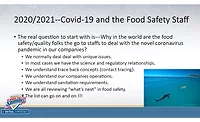The Role of Food Safety in the Insect Protein Sector

Credit: primalfuture-6748855 via Pixabay
One of the lesser-known sectors of the food industry is the insect protein sector. In spite of this sector’s seemingly nascent nature, it was valued at over $153 million in the year 2021 and is slated to grow to an exponential $856 million by 2029, expecting a consistent growth rate of over 24.1 percent. This, of course begs the question: what is insect protein?
The consumption of insects is known as entomophagy. In spite of its seeming anonymity in the western world, over 2 billion people are estimated to consume insect protein on a regular basis in Asia, South America, and Africa. Over 1,900 species of insects are consumed by humans worldwide, although the most common are the house cricket, giant water bug, and the water beetle.
Severe food insecurity has ramped up the need for increasingly sustainable sources of food. It is predicted that the global human population will increase to a whopping 9.8 billion by the year 2050, which will consequently increase the need for food by over 60 percent. Insect protein is being touted as the answer to a consistent and tenable food group, and more importantly, it is predicted to be the number-one sustainable protein source for future generations.
Apart from the obvious sustainability of the option itself, there are many other advantages to consuming insects on a commercial basis. Insects are known to contain much higher levels of protein than their animal counterparts, thereby allowing insects to take the lead as the more efficient protein alternative. For example, protein percentages for crickets and termites range from 61 percent to 35.5 percent, as compared to 26 percent for grass-fed chicken. 1,2 However, edible insects are still considered a "new" food product in the commercial food industry, and it is important to understand the unique food safety challenges they may pose, which could be biological, chemical, or allergenic in nature.
Biological Hazards
Biological hazards are a major food safety concern with respect to edible insect consumption.3 The risk of transmitting foodborne pathogens such as Staphylococcus aureus, Salmonella, and can be high if certain biosecurity measures are not implemented, such as:
- Adequate segregation of edible product from livestock
- Hygienic conditions of post-processing areas—i.e., where the product is being dried, for example.
Unlike most commercial food products, edible insects are consumed in their entirety, which poses problems for achieving effective decontamination. This also means that the methodology of rearing and farming of these insects is crucial to determining the products' eventual safety for human and animal consumption.
Nevertheless, the most alarming biological hazard associated with edible insects is the presence of spore-forming pathogens and spores. Highly toxic and dangerous pathogens such as Bacillus cereus and Campylobacter sordelli have been found in insects such as yellow mealworms, locusts, and house crickets. The toxins produced by these pathogens can cause great harm to humans and animals alike, and measures such as subjecting the food product to extreme heat will not help mitigate or eliminate these toxins.
Looking for quick answers on food safety topics?
Try Ask FSM, our new smart AI search tool.
Ask FSM →
Chemical Hazards
Although very little is known about the effect of external chemicals on the safety of edible insects, chemicals such as mycotoxins have been known to accumulate within certain types of edible insects.3 Exposure of insects during processing to agricultural waste, pesticides, and toxic metals have been known to increase the likelihood of product contamination. In these cases, it is important to adhere to strict hygiene measures within an edible insect processing facility, thereby minimizing exposure to these kinds of chemical hazards. Although reports exist of insects accumulating toxic metals within their system during the processing stage, not enough studies have been conducted by the scientific community with regard to contamination routes or even the metabolization of these contaminants, thereby making the implementation of adequate food safety measures even more difficult.
Allergenic Hazards
Although allergen information for edible insects is scarce, there have been various reports of consumers experiencing allergic reactions to different kinds of insects. For example, cases of allergic reactions to yellow mealworms have been reported in individuals who were also severely allergic to shellfish.3 Although specific allergens that may be found in edible insects are largely unknown, some researchers speculate that the processing methods used for edible insect processing may be a factor in the allergenic nature of the products themselves.
The current dearth of scientific studies is proving to be detrimental to the commercial introduction of insects to consumer palates. However, with the climate crisis looming on the horizon, it is of utmost importance that the food industry examine sustainable methods of protein production that would help curb food insecurity in the years to come. Food safety professionals, too, must conduct further studies on edible insect consumption to help quell doubts about the safety of this novel food.
- Orkusz, A. "Edible Insects versus Meat—Nutritional Comparison: Knowledge of Their Composition Is the Key to Good Health." Nutrients 13, no. 4 (2021): 1207. https://pubmed.ncbi.nlm.nih.gov/33917531/.
- Rumpold, B. and O. Schlüter. "Insect-based protein sources and their potential for human consumption: Nutritional composition and processing." ResearchGate. 2015. https://www.researchgate.net/publication/275016949_Insect-based_protein_sources_and_their_potential_for_human_consumption_Nutritional_composition_and_processing.
- Food and Agriculture Organization of the United Nations (FAO). "Looking at Edible Insects from a Food Safety Perspective: Challenges and Opportunities for the Sector." Rome, Italy. 2021. https://www.fao.org/3/cb4094en/cb4094en.pdf.









